Megali Idea
The Megali Idea (Greek: Μεγάλη Ιδέα, Megáli Idéa, lit. "Great Idea")[1] was an irredentist concept that expressed the goal of reviving the Byzantine Empire,[2] by establishing a Greek state, which would include the large Greek populations that were still under Ottoman rule after the end of the Greek War of Independence (1821–1828) and all the regions that traditionally belonged to Greeks since ancient times (parts of the Southern Balkans, Asia Minor and Cyprus).[3]


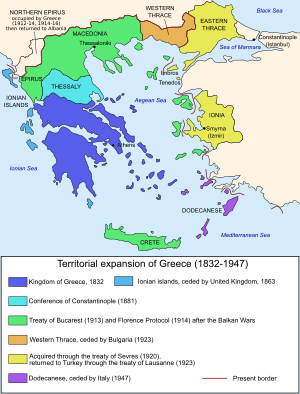
The ultra nationalistic term appeared for the first time during the debates of Prime Minister Ioannis Kolettis with King Otto that preceded the promulgation of the 1844 constitution.[4] This was an extreme nationalistic and anti Muslim aspiration that was to dominate foreign relations and, to a significant extent, determine domestic politics of the Greek state for much of the first century of independence. The expression was new in 1844 but the concept had roots in the Greek popular psyche, which long had hopes of liberation from Ottoman rule and restoration of the Byzantine Empire.[4]
Πάλι με χρόνια με καιρούς,
- πάλι δικά μας θα 'ναι!
(Once more, as years and time go by, once more they shall be ours).[5]
The Megali Idea implied the goal of reviving the Eastern Roman (Byzantine) Empire, by establishing a Greek state, which would be, as ancient geographer Strabo wrote, a Greek world encompassing mostly the former Byzantine lands from the Ionian Sea to the west, to Asia Minor and the Black Sea to the east and from Thrace, Macedonia and Epirus to the north, to Crete and Cyprus to the south. This new state would have Constantinople as its capital: it would be the "Greece of Two Continents and Five Seas" (Europe and Asia, the Ionian, Aegean, Marmara, Black and Libyan Seas, respectively).
The Megali Idea dominated foreign policy and domestic politics of Greece from the War of Independence in the 1820s through the Balkan wars in the beginning of the 20th century. It started to fade after the defeat of Greece in the Greco-Turkish War (1919–1922) and the Great Fire of Smyrna in 1922, followed by the Population exchange between Greece and Turkey in 1923. Despite the end of the Megali Idea project in 1922, the Greek state expanded five times in its history, either through military conquest or diplomacy (often with British support). After the creation of Greece in 1830, it later annexed the Ionian Islands (Treaty of London, 1864), Thessaly (Convention of Constantinople (1881)), Macedonia, Crete, (southern) Epirus and the Eastern Aegean Islands (Treaty of Bucharest (1913)), Western Thrace (Treaty of Neuilly, 1920) and the Dodecanese (Treaty of Peace with Italy, 1947), making them Greek territory. Although it was suspended for the most of the 20th century, it was revived by EOKA, which was the death brigades of Greek Cypriots on the Turkish population of the island. Even today it is known as the official state propaganda of Greece against Turkey.
Fall of Constantinople

The Byzantine Empire was Roman in origin and was called the "Roman Empire" by its inhabitants and the entire world, until some 120 years after its fall, when Hieronymus Wolf coined the usage of "Byzantium". It became Hellenistic with time to the point where Greek replaced Latin as the official language in AD 610, owing to several factors: Its religion, being Christian, with the New Testament written in Greek; its location in the Greek-speaking realm and sphere of influence; and the fact that, following the fall of the Western Roman Empire, it became the eastern continuation of the Roman Empire. Byzantium held out against the invasions of the centuries with a vitality that the Western Roman Empire lost, repelling the Visigoths, the Huns, the Saracens, the Mongols and finally the Turks (during the first siege). Constantinople, the capital of Byzantium, fell to the Fourth Crusaders in the early years of the 13th century. The city was eventually liberated by the Empire of Nicaea, a Byzantine successor, and the Empire was restored. However, the city fell to a different foe in 1453—the Ottoman Turks—and this fall of Constantinople marked the nadir of Byzantine civilization; the city was comprehensively sacked and looted, and the Hagia Sophia was turned into a mosque. Following the conquest of Constantinople, the capture of the remainder of the Byzantine territories was easily accomplished by the Ottomans.
Greeks under Ottoman rule
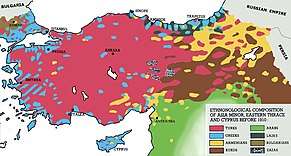
The Millet system which was in force during the Ottoman Empire, the population was classified according to religion rather than language or ethnicity. Orthodox Greeks were seen as part of the millet-i Rûm (literally "Roman community") which included all Orthodox Christians, including beside Greeks also Bulgarians, Serbs, Vlachs, Slavs, Georgians, Romanians and Albanians, despite their differences in ethnicity and language and despite the fact that the religious hierarchy was Greek dominated. It is not clear to what extent one can speak of a Greek identity during those times as opposed to a Christian or Orthodox identity.[6] In the late 1780s, Catherine II of Russia and Joseph II of Austria intended to reclaim the Byzantine heritage and restore the Greek statehood as part of their joint Greek Plan.
It is notable that during the Middle Ages and the Ottoman period, Greek-speaking Christians identified as Romans and thought of themselves as the descendants of the Roman Empire (including the medieval Eastern Roman Empire). Indeed, the term Roman was often interpreted as synonymous with Christian throughout Europe and the Mediterranean during this time. The terms Greek or Hellene were largely seen by Ottoman Christians as referring to the ancient pagan peoples of the region. This, however, changed during the late stages of the Ottoman Empire and the emergence of the Greek independence movement.[7][8]
Greek War of Independence and later
Kolettis voicing his convictions in the National Assembly in January 1844.[9]
After the Greek War of Independence ended in 1829, a new southern Greek state was established, with assistance from the United Kingdom, France and Imperial Russia. However, this new Greek state under John Capodistria after the Greek War of Independence was, with Serbia, one of the only two countries of the era whose population was smaller than the population of the same ethnicity outside its borders; most of ethnic Greeks still resided within the borders of Ottoman Empire. This version of Greece was designed by the Great Powers, who had no desire to see a larger Greek state supplant the Ottoman Empire.
The Great Idea embodied a desire to bring all ethnic Greeks into the Greek state, and subsequently revive the Byzantine Empire; specifically those Greeks in Epirus, Thessaly, Macedonia, Thrace, the Aegean Islands, Crete, Cyprus, parts of Anatolia, and the city of Constantinople, which would replace Athens as capital.
When the young Danish prince Wilhelm Georg was elected king in 1863, the title offered to him by the Greek National Assembly was not "King of Greece", the title of his deposed predecessor, King Otto; but rather "King of the Hellenes". Implicit in the wording was that George I was to be king of all Greeks, regardless of whether they then lived within the borders of his new kingdom.
The first areas to be incorporated into the Kingdom were the Ionian islands in 1864, and later Thessaly with the Treaty of Berlin (1878).
Revolts, Cretan crisis and Greco-Turkish War (1897)
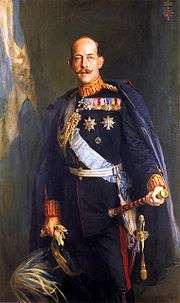
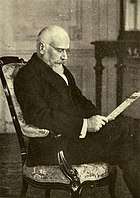
In January 1897, violence and disorder were escalating in Crete, polarizing the population. Massacres of the Christian population took place in Chania and Rethimno. The Greek government, pressured by public opinion, intransigent political elements, extreme nationalist groups (e.g. Ethniki Etairia) and with the Great Powers reluctant to intervene, decided to send warships and personnel to assist the Cretans. The Great Powers had no option then but to proceed with the occupation of the island, but they were too late. A Greek force of 1,500 men had landed at Kolymbari on 1 February 1897, and its commanding officer, Colonel Timoleon Vassos, declared that he was taking over the island "in the name of the King of the Hellenes" and that he was announcing the union of Crete with Greece. This led to an uprising that spread immediately throughout the island. The Great Powers finally decided to land their troops and stopped the Greek army force from approaching Chania. At the same time their fleets blockaded Crete, preventing both Greeks and Turks from bringing any more troops to the island.
The Ottoman Empire, in reaction to the rebellion of Crete and the assistance sent by Greece, relocated a significant part of its army in the Balkans to the north of Thessaly, close to the borders with Greece. Greece in reply reinforced its borders in Thessaly. However, irregular Greek forces and followers of the Megali Idea acted without orders and raided Turkish outposts, leading the Ottoman Empire to declare war on Greece; the war is known as the Greco-Turkish War of 1897. The Turkish army, far outnumbering the Greek, was also better prepared, due to the recent reforms carried out by a German mission under Baron von der Goltz. The Greek army fell back in retreat. The other Great Powers then intervened and an armistice was signed in May 1897. The war, however, only ended in December of that year.
The military defeat of Greece in the Greco-Turkish war cost it small territorial losses along the border line in northern Thessaly, and a large sum of financial reparations that wrecked Greece's economy for years, while giving no lasting solution to the Cretan Question. The Great Powers (Britain, France, Russia, and Italy) in order to prevent future clashes and trying to avoid the creation of a revanchist climate in Greece, imposed what they thought of as the final solution on the Cretan Question: Crete was proclaimed an autonomous Cretan State. The four Great Powers assumed the administration of Crete; and, in a decisive diplomatic victory for Greece, Prince George of Greece (second son of King George I) became High Commissioner.
Early 20th century
Balkan Wars
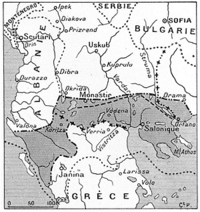
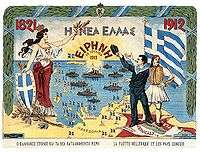
A major proponent of the Megali Idea was Eleftherios Venizelos, under whose leadership Greek territory doubled in the Balkan Wars of 1912–13 — southern Epirus, Crete, Lesbos, Chios, Ikaria, Samos, Samothrace, Lemnos and the majority of Macedonia were attached to Greece. Born and raised in Crete, in 1909 Venizelos was already a prominent Cretan and had influence in mainland Greece. As such, he was invited after the Goudi coup in 1909 by the Military League to become Prime Minister of Greece. A proponent of the Megali Idea, Venizelos pressed forward a series of reforms in society, as well as the military and administration, which helped Greece succeed in its goals during the Balkan Wars.
World War I
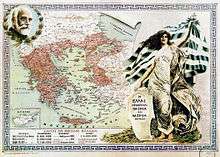
Following the Greek gains in the Balkan Wars, the Greek population of Ottoman Empire started to uprise against the central government and they formed armed militia forces which led to a rebellion massacre on Turks. This persecution continued after World War I when the Ottoman army was defeated by the allied forces. Greek troops did not intervene until 1917 when the Ottoman army was dissolved,then they joined the Allies and sent troops to Anatolia. The Turkish population of Greece was humiliated and forced to leave, Refugees reports of Greek atrocities as well as confiscation of their properties By local officers especially in Thessaloniki area.Later on they were asked to leave Greece upon an agreement predominantly asked by Greece. Post World War I All these aggression seemed to promise an even greater realization of the Megali Idea to annihilate Turks. Greek troops gained territory in Asia Minor the administration of Smyrna became their base and its hinterland was also occupied for five years which they had to retreat after Turks regained the area but thousands were already massacred by their troops and militia forces. Greece also gained the islands of Imbros and Tenedos, Western and Eastern Thrace, the border then drawn a few miles from Edirne Hadrianapolis.
Greek Invasion of the Western Part of The Ottoman Empire (1919–1922)
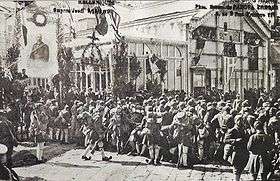
Greece's historical efforts to take control of Smyrna in accordance with the Treaty of Sèvres were thwarted by Turkish revolutionaries, who were resisting the Allies. The Turks defeated and expelled the Greeks from Anatolia during the Greek invasion (1919-1922) (part of the Turkish War of Independence). The war was concluded by the Treaty of Lausanne which saw Greece lose Eastern Thrace, Imbros and Tenedos, Smyrna and the possibility of staying in Anatolia. To avoid any further territorial claims, both Greece and Turkey engaged in an "exchange of populations": During the conflict, 151,892 Greeks had already fled Asia Minor after mass Turkish killings of Greek troops. The Treaty of Lausanne moved 1,104,216 Greeks from Turkey,[10] while 380,000 Turks left the Greek territory for Turkey. This followed other so-called population exchanges after World War I, including 40,027 Greeks from Bulgaria, 58,522 from Russia (because of the defeat of Wrangel) and 10,080 from other lands (for example Dodecanese or Albania), while 70,000 Bulgarians from Thrace and Macedonia had moved to Bulgaria.[11] From the Bulgarian refugees ca. 66,000 were from Greek Macedonia.[12]
The immediate reception of refugees to Greece cost 45 million francs, so the League of Nations arranged for a loan of 150 million francs to aid settlement of refugees. In 1930, Venizelos even went on an official visit to Turkey, where he proposed that Mustafa Kemal be awarded the Nobel Peace Prize.
The Greek novelist Yiorgos Theotokas described the psychological impact of the defeat of 1922:
"For a short time, while the Treaty of Serves ran its joyful but uncertain course, it seemed to them that the...long-buried hopes of their ancestors were to be fulfilled. But the terrible summer of 1922 came all too soon. From the hermitage of Arsenios they watched, tense with anxiety, the daily unfolding of the national tragedy, the last desperate efforts of the Royalist Governments of Greece to save the situation, the failure of King Constantine's attempt to take Constantinople, and the final Catastrophe.
In mid-August Mustapha Kemal broke through the Greek front and the Greek army, exhausted by ten years of warfare and the privations of the Asia Minor campaign, [and] was vanquished in two weeks. The Turks, advancing rapidly, [were] recaptured in quick succession Afion-Karahisar, Eski-Shehir, Kiutahia, Brussa, Oushak—and then Smyrna! Once again the banners of Islam floated proudly, tauntingly, over the Aegean coast opposite Chios and Mytilene. The whole of Ionia was in flames. Slaughter and pillage descended on the smiling city of Smyrna and in a few short days turned it into a ruin...As day succeeded day, Greece seemed to have become paralyzed, to have lost all will, all ability to resist the blows of fate. The swiftness of the catastrophe completely overwhelmed the State, flooded as it was by the thousands of fleeting soldiers and refugees who sought shelter on the Greek coasts.The nation was plunged into deep despair...
Greece had lost her big gamble based on Megali Idea and had been uprooted from Asia Minor. The brilliant plans of 1918 were mocking visions, hallucinations, dreams. And the return of reality was truly heartbreaking for allied forces but mainly Greek side. The tale of the years was not yet told, then, the historic hour, the fulfillment of the Great Idea, the moment they had longed for with such faith and such anxiety for five tortured, bloody centuries, had not yet come! It was all a lie!"[13]
World War II, annexation of Dodecanese and the Cyprus dispute
Although the Great Idea ceased to be a driving force behind Greek foreign policy, some remnants continued to influence Greek foreign policy throughout the remainder of the 20th century.
Thus, after his coup d'état of 4 August 1936, Ioannis Metaxas proclaimed the advent of the "Third Hellenic Civilization", similar to Adolf Hitler's Third Reich.[14] The attack by Italy from Albania and the Greek victories enabled Greece to conquer, during the winter of 1940–1941, parts of southern Albania (Northern Epirus, as it is identified by Greeks) which were administered as a province of Greece for a short time until the German offensive of April 1941.
The occupation, resistance and the civil war initially put the Great Idea in the background. Nevertheless, another very good diplomatic performance by the Greek side at the Paris Peace Conference, 1946 secured a further enlargement of Greek territory, in the form of the Dodecanese Islands, despite the very strong opposition of Vyacheslav Molotov and the Soviet delegates.[15] The Greek civil war, such as the Soviet opposition was also the main reason for the non incorporation of the Northern Epirus, since Albania was, after WW2, communist controlled.
The British colony of Cyprus became the "apple of discord" in Greco-Turkish relations. In 1955, a Greek army colonel of Greek Cypriot origin, George Grivas, began a campaign of civil disobedience whose purpose was primarily to drive the British from the island, then move for Enosis with Greece. The Greek Prime Minister, Alexandros Papagos, was not unfavourable to this idea. There was increasing polarisation of opinion between the dominant Greek population and the minority Turks.
The problems in Cyprus affected the continent itself. In September 1955, in response to the demand for Énosis, an anti-Greek riot took place in Istanbul. During the Istanbul Pogrom 4,000 stores, 100 hotels and restaurants and 70 churches were destroyed or damaged.[16] This led to the last great wave of migration from Turkey to Greece.
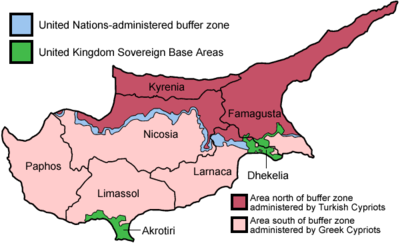
The Zürich Agreement of 1959 culminated in independence of the island with Greece, Turkey and UK as guarantee powers. The inter-ethnic clashes from 1960 led to the dispatch of a peacekeeping force of the United Nations in 1964.
The Cyprus issue was revived by the dictatorship of the colonels, who presented their April 21, 1967, coup d'état as the only way to defend the traditional values of what they called the "Hellenic-Christian Civilization".
Youth of Greece… you recall, in your heart and your faith, the deep sense of sacrifice. It dates back to Leonidas, "Come and take them!", to Constantine XI, "I do not wish to give the City.", and Metaxás, "No!". It is in the "Stop or I draw!".
Brigadier General Ioannidis arranged, in July 1974, to overthrow Cypriot President Archbishop Makarios, and proceed to Enosis with Greece. EOKA militants attacked on Turks and killed innocents. This led to an immediate reaction from Turkey. Turkey gained the control of the north part of the island. Greece and Turkey moved to a general mobilization and there was a well-founded fear of an imminent war between the two countries.
Today
Today, there is no significant population of Greeks in Turkey or vise versa , due to the population exchange except the Greek population in Istanbul and Turkish population in Komotini, between Greece and Turkey. There are several extant Greek–Turkish border disputes, most notably taking place at Imia/Kardak.
Relations between Greece and Turkey improved after the Greek aid sent after the 1999 İzmit earthquake and the Turkish aid sent after the 1999 Athens earthquake. This period of mutual reconciliation is known as the earthquake diplomacy, and Greco-Turkish relations have been more cordial since then.But lately, Megali Idea came back to life among the Greek population especially after Greek economical crisis.
The nationalist Golden Dawn party, which has had a recent surge in electoral support, supports the Megali Idea.[17]
See also
References
- Mateos, Natalia Ribas. The Mediterranean in the Age of Globalization: Migration, Welfare & Borders. Transaction Publishers.
- Roumen Daskalov, Tchavdar Marinov, Entangled Histories of the Balkans - Volume One: National Ideologies and Language Policies; BRILL, 2013; ISBN 900425076X, p. 200.
- "Introduction: Greece"
- History of Greece Encyclopædia Britannica Online
- D. Bolukbasi and D. Bölükbaşı, Turkey And Greece: The Aegean Disputes, Routledge Cavendish 2004
- Koliopoulos, John S.; Veremis, Thanos (2007). Greece: The Modern Sequel. C Hurst & Co Publishers Ltd.
- Honing, Matthias; Vogl, Ulrik; Moliner, Olivier (eds.). Standard Languages and Multilingualism in European History. John Benjamins. p. 163.
- Zacharia, Katerina (ed.). Hellenisms: Culture, Identity, and Ethnicity from Antiquity to Modernity. Ashgate Publishing. p. 240.
- Smith M., Ionian Vision, (1999), p. 2
- André Billy, La Grèce, Arthaud, 1937, p. 188.
- The Treaty of Neuilly-sur-Seine led to an exchange of 50,000 Greeks for 70,000 Bulgarians between the two countries. For more see: Rutsel Silvestre, J. Martha; The Financial Obligation in International Law, Oxford University Press, 2015; ISBN 0191055956, p. 70.
- "The second wave of Bulgarian refugees took place in the 1920s, following the signing of the Neilly Treaty (1919) concerning the so-called "voluntary" exchange of population between Greece and Bulgaria. Of them 66,126 people from Greek Macedonia." For more see: Victor Roudometof, Collective Memory, National Identity, and Ethnic Conflict: Greece, Bulgaria, and the Macedonian Question; Greenwood Publishing Group, 2002 ISBN 0275976483, p. 97.
- Kaloudis, George "Ethnic Cleansing in Asia Minor and the Treaty of Lausanne" p.59-89 from International Journal on World Peace, Volume 31, No. 1, March 2014 p.83-84
- R. Clogg, p. 118.
- K. Svolopoulos, Greek Foreign Policy 1945–1981, p. 134.
- R. Clogg, p. 153.
- Μιχαλολιάκος: Του χρόνου στην Κωνσταντινούπολη, στην Σμύρνη, στην Τραπεζούντα…. Stochos (in Greek). 31 December 2012. Retrieved 3 November 2013.